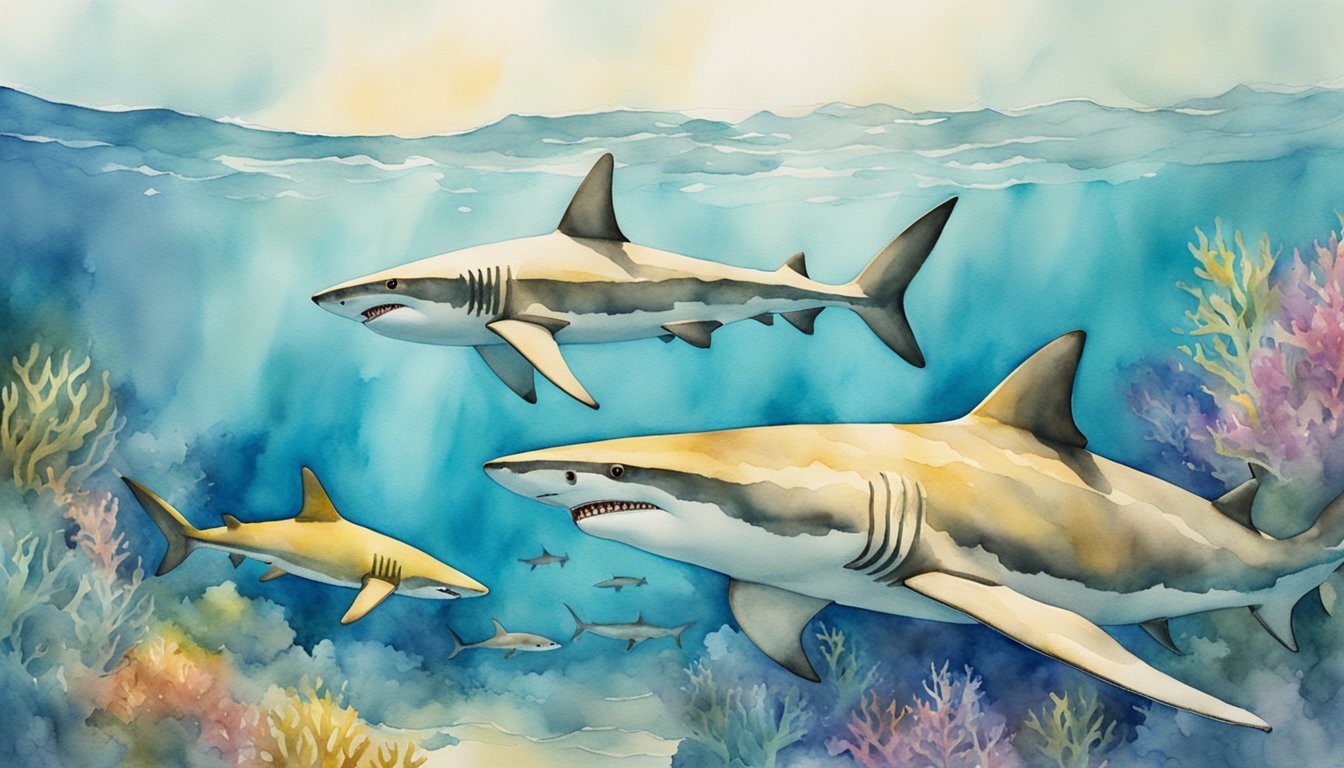Shark Vision and Color Perception
Shark vision is a complex sensory system which has evolved uniquely among aquatic animals. Investigating the retinal structure of sharks and the composition of photoreceptors within provides insights into how they perceive their underwater environment, particularly regarding color.
Understanding Shark Retinas
Sharks’ retinas are equipped with both rod and cone cells which play distinct roles in visual processing. The rod cells are abundant and are known for their sensitivity to low light levels, contributing to sharks’ strong night vision. Meanwhile, the cone cells, although less populous, are instrumental in color vision. However, whether these cone cells enable sharks to perceive color as humans do is a point of scientific inquiry. Studies using microspectrophotometry have examined these retinal cells to determine the types of visual pigments present which correlate with color perception abilities.
Photoreceptors and Color Vision
Sharks have two primary types of photoreceptor cells within their retinas – rods and cones. Rods are extremely sensitive to light, allowing sharks to see in murky waters or the dim light of greater ocean depths. The cone cells are responsible for color vision and exist in fewer numbers than rods in shark retinas. The types and quantities of cone photoreceptor cells vary across different shark species which leads to varying abilities in color discernment. Some sharks are considered cone monochromats, having only one type of cone receptor, which could suggest a limited color vision capacity similar to being color blind.
Color Vision in Different Shark Species
Different shark species exhibit varying spectrums of color vision. For instance, the nurse shark has been found to have only a single cone spectral type, indicating it may not distinguish colors in the same way humans do. Conversely, some species may have more than one cone type, suggesting the possibility of a more nuanced color perception. The research on the color vision abilities of sharks such as the tiger shark and bull shark, using direct behavioral responses to visual stimuli, have been enlightening yet continue to develop our understanding of how these animals perceive their world. The true extent of color vision in sharks remains partially unknown, with ongoing studies seeking to elucidate this aspect of their sensory capabilities.
Sharks’ perception of visual contrast rather than distinct colors may play a more significant role in their behavioral ecology, assisting with hunting and navigation through diverse marine environments. Understanding the color vision abilities in these species necessitates a closer look at the photoreceptor cells and cone visual pigments across various shark taxa.
Sharks in Their Marine Environment

Sharks have adapted remarkably well to their marine environment, with their sensory systems fine-tuned for successful predation and interaction within their underwater world.
Predatory Behaviors and Sensory Adaptation
Sharks exhibit complex predatory strategies supported by their highly developed sensory systems. Their vision is tailored to detect contrast rather than colors, with experiments suggesting most sharks may perceive the world in black and white due to a predominance of rod cells over cones in their retinas. This adaptation aids in the detection of prey against the backdrop of the ocean, regardless of the depth. The sharp contrast between light and darkness becomes more crucial in the deep water where light is scarce, while in shallow water, the brightness of the environment helps sharks to identify movement and size rather than the specific hues of their potential meal.
The Impact of Color Perception on Shark Interactions
The limited color vision of sharks is thought to affect their interactions with their environment and other marine life, including fish, seals, and even humans. As cone monochromats possessing long-wavelength-sensitive cones, they may not distinguish between certain colors, such as red and green. While this might seem like a disadvantage, it is actually part of a convergent evolution where sharks have developed other keen senses, such as smell, to locate prey. However, the similarity of colors in fishing gear and natural prey like seals may inadvertently contribute to shark bycatch in long-line fisheries and unintended shark attacks on humans due to confusing swimming attire or surf craft with natural prey.
Sharks and Human Activities
Human activities have a significant impact on sharks and their habitat. Overfishing and bycatch due to long-line fishing lures can disrupt shark populations as they are inadvertently caught alongside targeted fish species. Moreover, fishing gears and swimming paraphernalia that do not consider the sharks’ retinal capabilities and light perception may inadvertently increase the risks of attack near ocean surfaces. Universities like the University of Western Australia and University of Queensland have been involved in studying shark behavior and sensory adaptation to better manage human-shark interactions and the design of fishing gear to reduce bycatch. The knowledge of sharks’ sensory adaptations is not only pivotal in addressing conservation efforts but also in enhancing our understanding of these impressive predators’ roles within the marine ecosystem.

